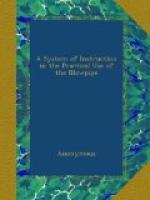(d.) Tellurium (Te).—This is one of the rare metals. It occurs very seldom in the metallic state, but often with bismuth, lead, silver, and gold. Tellurium, in the pure state, is silver-white, very bright, of a foliated or lamellar structure, brittle, and easily triturated. It is inclined to crystallize. It is soluble in concentrated sulphuric acid without oxidation. The solution is of a fine purple color, and gives a precipitate with the addition of water.
Tellurium in the Metallic form.—By the aid of heat it is oxidized in sulphuric acid, a portion of the oxygen of the acid oxidizing the metal, while sulphurous acid gas escapes. This solution is colorless, and is tellurous acid, dissolved in sulphuric acid. It melts at a low red heat, and volatilizes at a higher temperature. If tellurium is heated with free access of air, it takes fire, and burns with a blue color, the flame being greenish at the edges, while a thick white vapor escapes, which has a feeble acidulous odor.
Tellurous Acid (TeO^{2}) is of a fine, granulous, crystalline or white earthy mass, which is partly soluble in water. The solution has a strong metallic taste, and an acid reaction upon litmus paper. Heated in a tube closed at one end until it begins to glow, it fuses to a yellow liquid which is colorless, crystalline, and opaque when cold. Beads of it remain usually transparent like glass. Heated upon platinum wire in the flame of oxidation, it melts, and is volatilized as a white vapor. When heated upon charcoal in the oxidation flame, it melts, and is reduced to the metallic state, but volatilizes and a sublimate of white tellurous acid is formed upon the charcoal. The edge of this deposit is usually red or dark-yellow.
Heated upon charcoal in the flame of reduction, it is rapidly reduced, the external flame exhibiting a bluish-green color.
Borax dissolves it in the oxidation flame upon platinum wire to a clear colorless bead which turns grey when heated upon charcoal, through the presence of reduced metallic particles. Upon charcoal, in the reduction flame, the bead is grey, caused by the reduced metal. After a continued blast, tellurium is completely volatilized, and the bead appears clear again, while a white sublimate is deposited upon the charcoal.
With microcosmic salt, the same reactions are produced.
With carbonate of soda, tellurous acid fuses upon platinum wire to a clear colorless bead, which is white when cold. Upon charcoal it is reduced, and forms tellur-sodium, which is absorbed by the charcoal, and metallic tellurium, which is volatilized, and deposits upon the charcoal a white incrustation (tellurous acid).
If tellurous acid, finely powdered charcoal, and carbonate of soda are mixed together, and the mixture be well ignited in a closed tube, until fusion is effected, and a few drops of boiled water are brought into the tube, they are colored purple, indicating the presence of tellur-sodium.




